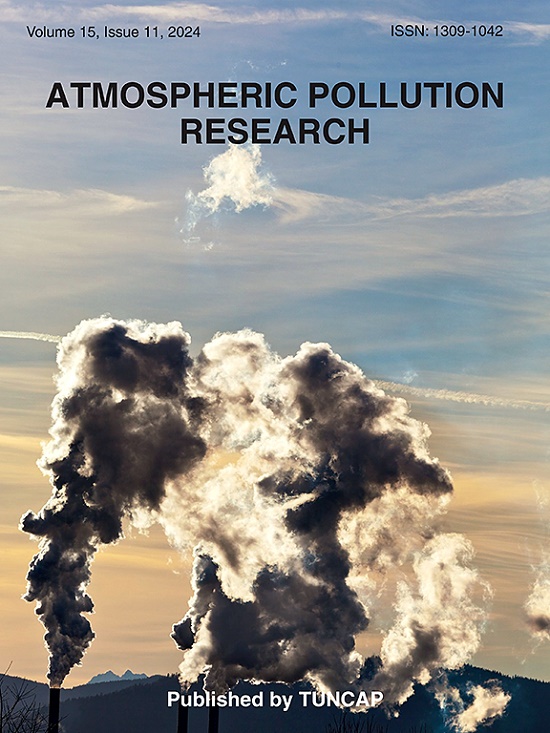Role of aerosols on prolonged extreme heatwave event over India and its implication to atmospheric boundary layer
IF 3.9
3区 环境科学与生态学
Q2 ENVIRONMENTAL SCIENCES
引用次数: 0
Abstract
The extreme heatwave event is a major threat to living beings in the warming climate which demands immediate quantification of the meteorological factors triggering its amplification. In this study, we explored the role of absorbing and scattering aerosols in the occurrence of extreme heatwave events as well as changes in the atmospheric boundary layer (ABL) over the northwest (NW) and east coast (EC) India during March–June 2017–2022. Ten dry (RH < 33 %) and nine moist (RH > 55 %) heatwave events are observed over the study period. Among these cases, a dry heatwave over NW region prolonged from 27 May to June 11, 2019 is explored in detail. In this case, the increased ABL height from ∼2.0 to 3.0 km to ∼4.0–5.0 km is observed and the entire ABL depth shows enhanced temperature by ∼4 K. The latent and sensible heat fluxes are found to be reduced by 50 W/m2 and enhanced by 80 W/m2 respectively during heatwave. The total aerosol optical depth (AOD) is gradually enhanced to 0.6 leading to enhanced atmospheric warming of ∼8.5–11.5 W/m2 during the heatwave event. Furthermore, the heating rates for moist heatwave cases (∼2 K/day) are higher than those for dry heatwave cases (∼1.8 K/day). In addition, the moist heatwaves exhibit a higher concentration of PM2.5 (∼80–120 μg/m3) compared to the dry heatwave (∼60–100 μg/m3) posing a greater threat to public health and air quality.
气溶胶在印度长时间极端热浪事件中的作用及其对大气边界层的影响
极端热浪事件是气候变暖对生物的主要威胁,需要立即量化引发其放大的气象因素。在这项研究中,我们探讨了2017年3月至2022年6月期间印度西北部(NW)和东海岸(EC)大气边界层(ABL)的变化以及气溶胶的吸收和散射在极端热浪事件发生中的作用。十干(RH <;33%)和9个湿润(RH >;55%)的热浪事件在研究期间被观测到。其中,详细探讨了2019年5月27日至6月11日西北地区持续的干燥热浪。在这种情况下,观测到ABL高度从~ 2.0 ~ 3.0 km增加到~ 4.0 ~ 5.0 km,整个ABL深度显示出温度升高~ 4 K。潜热通量和感热通量分别减少50 W/m2和增加80 W/m2。在热浪事件期间,总气溶胶光学深度(AOD)逐渐增加到0.6,导致大气变暖增加~ 8.5-11.5 W/m2。此外,湿热浪的升温速率(~ 2 K/天)高于干热浪的升温速率(~ 1.8 K/天)。此外,湿热浪的PM2.5浓度(~ 80 ~ 120 μg/m3)高于干热浪(~ 60 ~ 100 μg/m3),对公众健康和空气质量构成更大的威胁。
本文章由计算机程序翻译,如有差异,请以英文原文为准。
求助全文
约1分钟内获得全文
求助全文
来源期刊

Atmospheric Pollution Research
ENVIRONMENTAL SCIENCES-
CiteScore
8.30
自引率
6.70%
发文量
256
审稿时长
36 days
期刊介绍:
Atmospheric Pollution Research (APR) is an international journal designed for the publication of articles on air pollution. Papers should present novel experimental results, theory and modeling of air pollution on local, regional, or global scales. Areas covered are research on inorganic, organic, and persistent organic air pollutants, air quality monitoring, air quality management, atmospheric dispersion and transport, air-surface (soil, water, and vegetation) exchange of pollutants, dry and wet deposition, indoor air quality, exposure assessment, health effects, satellite measurements, natural emissions, atmospheric chemistry, greenhouse gases, and effects on climate change.
 求助内容:
求助内容: 应助结果提醒方式:
应助结果提醒方式:


